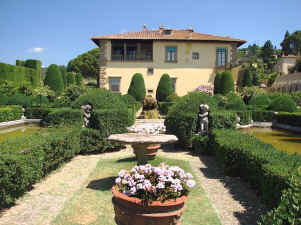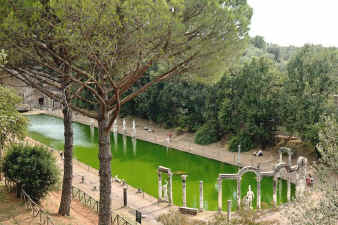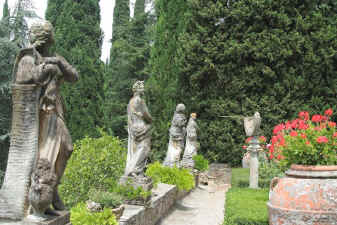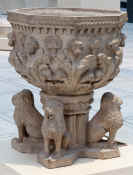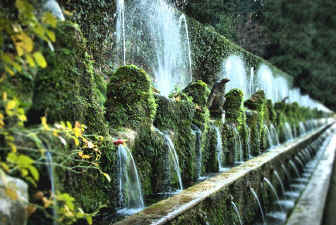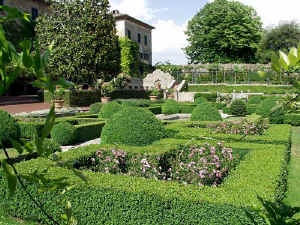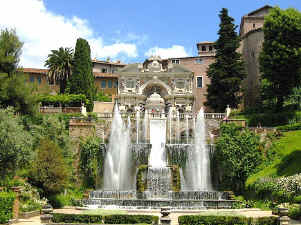From the beginning of the period that we call the early Florentine
Renaissance in the 15 C, a Tuscan villa was a large country house,
sometimes fortified but completely unlike a mediaeval castle in
appearance, and usually situated on an agricultural estate. Some of these
villas, notably those constructed by the Medici and their friends, became increasingly centred around the pursuit of
scholarly leisure, and, as classical literature became more accessible, were
remodelled according to the ideals and also probably the practice of
Augustan Rome. Villa Gamberaia and its garden, Tuscany Although seeking a refuge from urban life, the owners of villas were greatly involved in civic activity. This meant that their villas were usually close to the main political centres: Rome (papal villas at Frascati), Florence (Medici villas at Fiesole and in the Mugello), Milan and Venice (Palladian villas of the Veneto), and later Pisa, Sienna and Lucca. For both practical and aesthetic reasons, owners chose their site with care. The need for flowing water - to supply the villa, irrigate the garden and power the fountains - led them to prefer hillside locations with natural springs. These sites offered dramatic views over valleys, rivers and lakes, and, never to be overlooked, also cool breezes in mid-summer. Tuscan garden statuaryIntense study of classical literature, both in the original latin and later in Italian translation, allowed Renaissance scholars and other members of the reading classes to conceptualise Roman garden layout in a manner that subsequent archaeology and the discovery of frescoes illustrating gardens show to have been remarkably accurate. Part of the garden of Hadrian's villa (Villa Adriana) near Tivoli. Consciously emulating the gardens of ancient Rome, Renaissance grandees adorned the grounds of villas with an array of statuary. Excavated Roman statuary was re-used, restored, modified or displayed in fragments. In addition, new works were commissioned. Some were copies of Roman sculpture - gods, goddesses and fantastic creatures taken from mythology. Sculpture of animals, both wild and domestic, was also popular. The placement of these works was carefully planned and integrated into the overall design of the garden. Garden statuary was used to decorate fountains, line paths, mark the corners of compartments and act as monumental centrepieces to a design. Villa Peyron al Bosco di Fonte Lucente The use of water in Tuscan gardens
During the Renaissance the manipulation of water, through spectacular fountains, rushing cascades and ingenious
follies, became the greatest manifestation of garden art.
Designers often used fountains as isolated decorative elements in a vista. This would visually link separate parts of the garden and encourage visitors to wander throughout the grounds. These water features often incorporated figure sculpture that integrated water with wider decorative schemes. Water features at the Villa d'Este at Tivoli near Rome Tuscan villa garden designHorticulture, particularly the distribution of the plants, was central to the design of Italian Renaissance gardens. It was the
principal means of dividing and adorning the space, and through its subtle manipulation of planting schemes - the placement,
normally highly symmetrical, and height of hedges, for example - it determined how visitors experienced a garden.
At the turn of the 19 C, the presence of permanent community of
Anglo-Florentines deeply involved in the restoration of their villas
resulted in the fashion for the giardino all'inglese, essentially
a non-symmetrical garden with flowering plants predominating and
deciduous trees in evidence. During the past forty years, the fashion
has swung back to the giardino all'italiana, in effect, a
Renaissance garden, to the extent that the visitor to Tuscany has to
search hard to find extensive flower beds forming part of the garden of
a Tuscan villa. Renaissance garden at Badia a Coltibuono Architecture of Renaissance gardensThe architectural legacy of the Roman world was the inspiration for many of the structures that were integrated into Renaissance gardens. Open-air theatres, covered walkways and monuments consecrated to nymphs were modelled on ancient Roman precedents, in some cases rivalling or surpassing in splendour the originals from which they drew their inspiration. With their allusions to the classical world, they provoked associations in the mind of the visitor, as well as providing for stage events or simply escape from the heat of the sun. Much of the architecture in gardens was both decorative and structural. Terraces needed the support of vast retaining walls, often embellished with niches and sculpture and topped with elaborate balustrades, while monumental staircases were required to link the levels of gardens. Fountains and retaining walls at the Villa d'Este at Tivoli near Rome |
